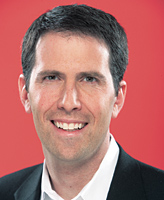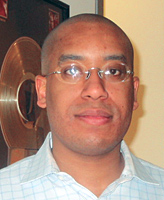Tech-savvy
consumers want on-demand offerings, challenging the entertainment
industry's established marketing models and distribution channels.
Who holds the plug?
By
Aubrey Henretty
The
Internet's disruptive power just won't leave the entertainment
industry alone.
Six
years after the Recording Industry Association of America
felled Napster and two years after the Motion Picture Association
of America — and the U.S. Department of Homeland Security
— dismantled the massive movie-sharing aid elitetorrents.com,
consumers still flock to the Internet for music and video,
legal and otherwise. They cling stubbornly to the notion that
they should be allowed to dictate the terms of their entertainment
experience.
This
flagrant disregard for the rules of commerce is clearly a
problem without historical parallel. Or is it?
"We
have seen this movie before many times," says Mohanbir
Sawhney, the Kellogg School's McCormick Tribune Professor
of Technology.
Though
the actors vary, the plot stays the same: Technology meets
aging business model, consumers embrace technology, flustered
industry condemns this interloper, technology proves essential
to industry's survival. Sawhney recalls the panic that swept
through the film industry with the advent of the affordable
videocassette recorder. The VCR was simply a tool of pirates,
cried executives and their lawyers. Meanwhile, VCRs were popping
up in living rooms everywhere and the crunch of microwave
popcorn was drowning out industry objectives.
But
the show wasn't over. Reluctantly, the film industry discovered
that it was dealing with a new kind of consumer, one who wanted
to watch movies on her own time, even in her own home. Eventually,
the industry learned to love the sinister playback device,
in turn creating untold billions in revenue through home video
rentals and sales. So, concludes Sawhney, "What saved
the movie industry? The VCR."
Sawhney,
also the director of the Kellogg
School's Technology Industry Management Program, says
anxious managers in traditional media production and distribution
companies should loosen their white-knuckled grip on the reins.
"They need to get past the mentality that they are in
control of everything," he says. "So what if somebody
takes a five-minute clip of 'Desperate Housewives' and posts
it on YouTube? That's advertising."
Part
social networking site and part file-sharing hub, YouTube
(acquired by Google Inc. in 2006 for $1.65 billion) became
the latest online craze to drive traditional media companies
nuts with its meteoric rise from obscurity to ubiquity. Users
could upload video clips, watch others' clips and even embed
YouTube's player in their own Web pages.
| |
 |
| |
Chris
Maxy '97 |
| |
|
"[YouTube's
founders] came up with this great interface — which
is now copied by just about everybody — that made the
user experience very easy," says Chris Maxcy '97,
vice president of business development at YouTube, who adds
that the site appeals to the next generation of media consumers
in part because it allows users to control their entertainment
experience. Users found creative ways to express this freedom.
Some uploaded hours of home videos of kittens battling household
objects; others produced cleverly choreographed music videos
to promote their rock bands; and others still dumped digital
collections of old commercials and — to the frustration
of many rights holders — clips of TV shows onto the
site's servers.
"The
No. 1 priority with the company, ahead of everything else,
is the user," says Maxcy. "At the same time, we
do respect our copyright holders. That's sometimes where the
rub comes in."
Indeed.
The average 18- to 34-year-old takes a notoriously dim view
of copyright law. Members of this deep-pocketed, media-hungry
demographic grew up programming their parents' VCRs to record
network sit-coms and copy rented movies, and many of them
exhibited no qualms about posting copyrighted material to
YouTube.
While
some TV networks cried foul and demanded that their clips
be removed from the site, others accepted YouTube's olive
branch: a chance to reach the site's massive audience on the
networks' own terms. "The companies [that have partnered
with YouTube] really see us as this incredible new distribution
model," says Maxcy, who adds that CBS — one of
the first networks to form an official partnership with YouTube
— found that when it promoted its programming via clips
posted to the site, ratings rose.
"We
take [copyright infringement complaints] incredibly seriously,
and so we act quickly to remove any content that may have
been uploaded by someone who doesn't own it," Maxcy says.
Media
ownership, it turns out, is tricky business. If a consumer
pays for a piece of copyrighted music or video, who "owns"
it — the consumer or the copyright holder? If the consumer,
then how will the copyright holder protect the material? If
the copyright holder, then what exactly is the consumer paying
for?
 |
|
| Brian
Shults '05 |
|
| |
|
Brian
Shults '05, director of new business development at BMG
Music Publishing, says questions like these are critical to
address if the industry is to leverage the digital technologies
foisted upon it.
But
traditional ways of doing business can sometimes slow the
way that some companies react to these changes, he suggests.
While music publishers may be eager to embrace new platforms
— provided the platforms include proper compensation
for rights-holders — technology often outpaces copyright
law, he adds. The key to answering questions about ownership,
Shults says, is to spell out the rights at the time of purchase.
He posits that one-size-fits-all pricing and distribution
have passed: "Consumers should be willing to pay for
the number of rights they want to have."
Shults
adds that music companies also can benefit from understanding
how consumers want to listen to the music they buy. Do consumers
just want to audition a track a few times? Do they want unlimited
listens? Do they want to be able to copy the track or album?
If so, do they want to make one copy? Five? Fifteen? Once
record companies figure out exactly how consumers interact
with their media, says Shults, the market will determine appropriate
consumer prices for each use.
Sound
simple? It isn't. Media isn't just for televisions, computers
and music players anymore. With cellular phone networks rapidly
approaching broadband speed, says Paul Bernard '98, market
development director at Nokia Inc., content producers, cell
phone service providers and device makers are suddenly vying
for media-savvy consumer affections.
"Everyone
wants to control the end-user experience," says Bernard,
and as service providers cut exclusive deals with content
producers, device makers like Nokia must choose which formats
to support or bypass their sister industries with new formats
of their own. "What you are finding are these breakthrough
devices" designed to do one thing extremely well and
to integrate all aspects of the market, he says, citing the
Blackberry, a portable e-mail device with its own e-mail provider,
and the iPod, a portable music player with its own music store.
Though
Bernard says it's tempting for device makers to add many functions
to their gadgets simply because they can, they are better
served by asking themselves, "What are the things that
the user really wants to do with the device, and what is the
context?" He adds, "Can you use your phone as a
remote control for your TV? Yeah, probably, but the remote
actually works pretty well."
Bernard
says that no matter how complicated new technology becomes,
no matter how drastically it changes the market or consumer
expectations, simplicity will remain the most direct line
to the consumer's heart.
"If
you can package it in a way that's easy — brainlessly
easy — for the end user, that's when things are really
going to take off." |



